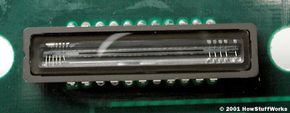Anatomy of a Scanner
Parts of a typical flatbed scanner include:
- Charge-coupled device (CCD) array
- Mirrors
- Scan head
- Glass plate
- Lamp
- Lens
- Cover
- Filters
- Stepper motor
- Stabilizer bar
- Belt
- Power supply
- Interface port(s)
- Control circuitry
The core component of the scanner is the CCD array. CCD is the most common technology for image capture in scanners. CCD is a collection of tiny light-sensitive diodes, which convert photons (light) into electrons (electrical charge). These diodes are called photosites. In a nutshell, each photosite is sensitive to light -- the brighter the light that hits a single photosite, the greater the electrical charge that will accumulate at that site.
Advertisement
Photons hitting a photosite and creating electrons
The image of the document that you scan reaches the CCD array through a series of mirrors, filters and lenses. The exact configuration of these components will depend on the model of scanner, but the basics are pretty much the same.
On the next page, you will see just how all the pieces of the scanner work together.
